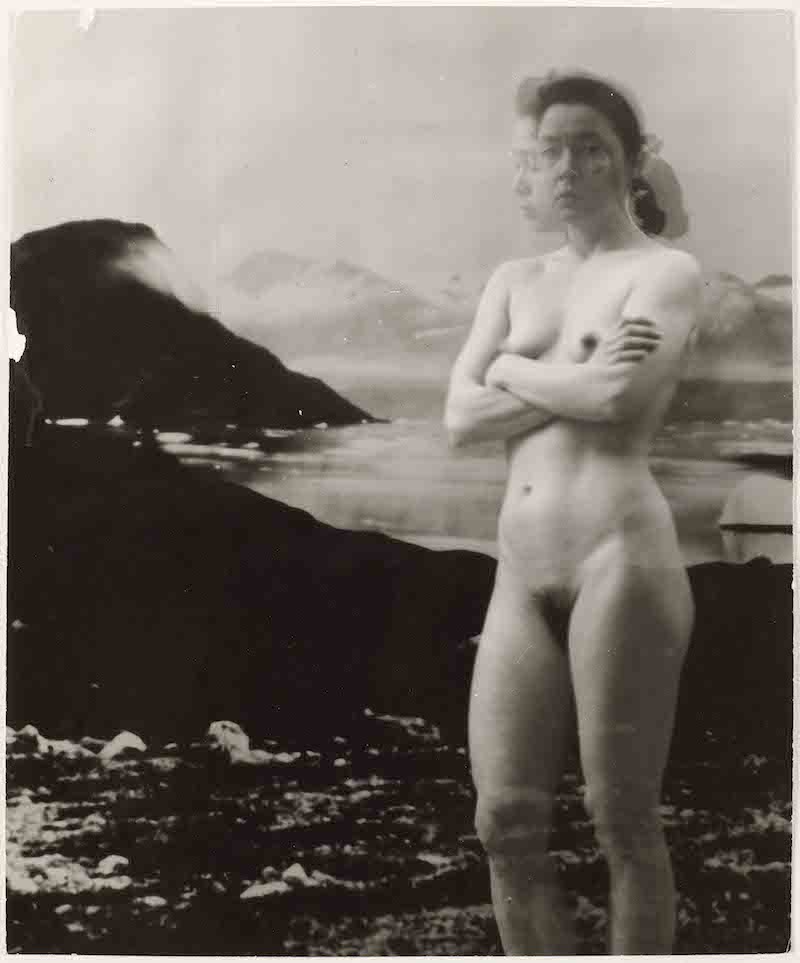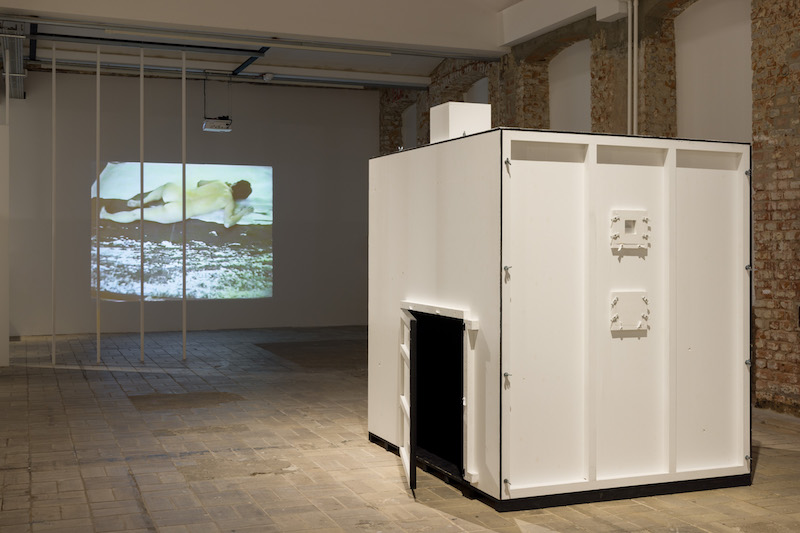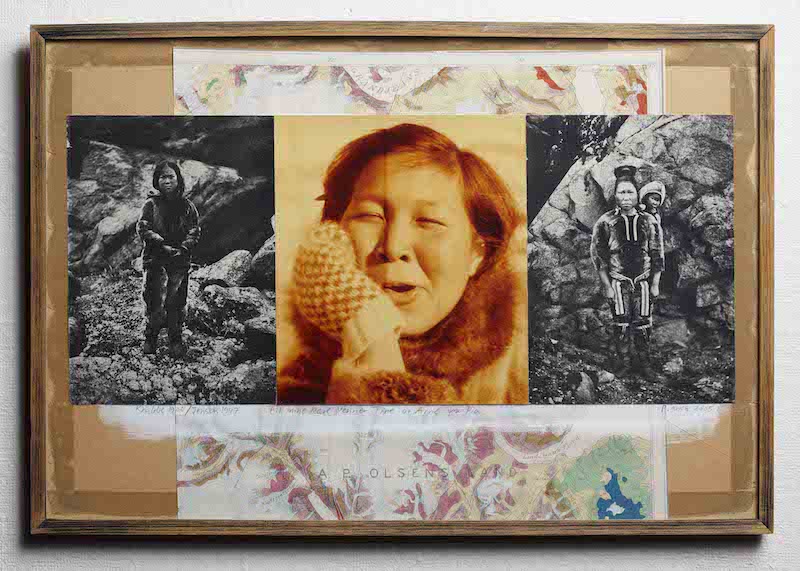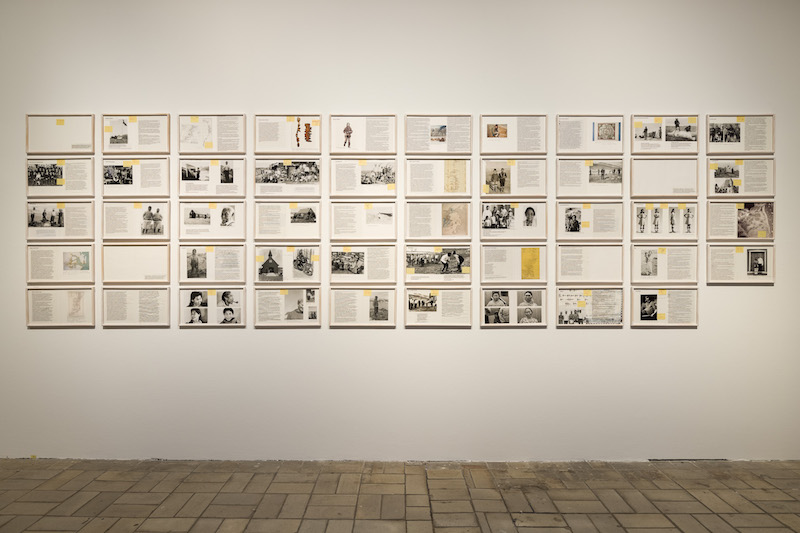by Josefin Granetoft // July 26, 2024
In one of her numerous self-portraits taken against the panorama of the Nuugaarsuk coastal point in South Greenland, Greenlandic-Danish artist Pia Arke (1958-2007) gazes inwards and meets the viewer’s eye, at once. Through double exposure, she presents herself as two overlapping, almost ghost-like figures, partly blending with the rocky landscape behind her. The dual gesture is emblematic for Arke’s to and fro between personal and collective history, using subjective and shared perspectives to address the colonial history of her native countries. Displayed across two floors of KW Institute for Contemporary Art, the exhibition ‘Arctic Hysteria’ presents over a hundred of the artist’s photographic, video and installation works that highlight her contribution to decolonial art and critique of the Arctic region.

Pia Arke: ‘Selvportræt (Self-Portrait),’ 1992, photography // Courtesy Pia Arke Estate, private collection © Pia Arke Estate
The first gallery of the exhibition focuses on Arke’s investigation of image-making and representation, epitomized by the reconstruction of her human-sized camera obscura, placed center stage. The wooden box was custom-built according to Arke’s dimensions, allowing her to step into the photographic apparatus and manipulate the exposure with her own body. Facing the box are several of Arke’s landscape photographs captured with the camera obscura technique, as well as a framed manuscript announcing the artist’s project. “In my choice of the camera obscura to take pictures lies the discovery of a sense of belonging both with the camera and with the places where I take the pictures,“ Arke declared, before embarking to Greenland with the intention of capturing the places she had lived in as a child, resulting in the series of landscapes and self-portraits on display.

Pia Arke: ‘Arctic Hysteria,’ 1996 // Courtesy Louisiana Museum of Modern Art, Humlebæk, Denmark, ©mPia Arke Estate (back) and Pia Arke: ‘Camera Obscura,’ 1990/2024 // Courtesy Pia Arke Estate, © Pia Arke Estate (front), installation view of the exhibition ‘Pia Arke–Arctic Hysteria’ at KW Institute for Contemporary Art, Berlin 2024 // Photo by Frank Sperling
Photographic layering and distortion are central to Arke’s artistic technique. Besides stepping into the camera to manipulate the exposure process, the video ‘Arctic Hysteria’ (1996) sees the artist crawl over a blowup photostat of the Greenlandic landscape photograph, re-appropriating the surface of the image as a performative stage. The title refers to a mental condition of Inuit women reported by Western explorers, exemplifying the asymmetrical power of colonizing powers to name and classify the colonized. In the video, Arke crawls naked and on all fours across the image, before tearing at its edges, ripping it apart. The scraps of paper are strewn over her body, marking a disruption of the representational order. In other photographic prints displayed in the exhibition, the same landscape image is torn, scribbled over and marked with footprints, reiterating the inscription of the artist’s messy, subjective presence in place of a singular perspective.

Pia Arke: ‘Krabbe 1906 /Jensen 1947,’ 2005, collage // Courtesy Pia Arke Estate, private collection © Pia Arke Estate
Determining her own self-presentation, Arke’s photographic stagings reverse the colonial and ethnographic gaze that objectifies the indigenous subject. In other works, she appropriates and deconstructs the artefacts of Western knowledge-production: ethnographic studies, archives and maps. The installation ‘May Only Be Touched with Thumb and Little Finger’ (1999), presented on the upper floor of the exhibition, is a vertebrae-like column of stacked papers, extracted from the scientific periodical ‘Meddelelser om Grønland’ (Reports on Greenland). Next to the installation one can view a video of Arke stacking the same documents, while a paleontologist of the Danish Geological Museum describes a fossil named after the ‘tupilak’ monster of Inuit tradition. Juxtaposing myth and science, assembling a spine of the disassembled book pages, the works point to the constructed nature of both knowledge systems.

Pia Arke: ‘Dummy,’ 1997/2003 // Courtesy Nuuk Art Museum, © Pia Arke Estate, installation view of the exhibition ‘Pia Arke–Arctic Hysteria’ at KW Institute for Contemporary Art, Berlin 2024 // Photo by Frank Sperling
The exhibition concludes with ‘Dummy’ (1997/2003), a set of collages based on Arke’s book ‘Stories for Scoresbysund’ (2003), one of her last projects before her untimely death from cancer in 2007. The work documents her research into Ittoqqortoormiit (formerly called Scoresbysund), and attempt to piece together the town’s displaced history through photographs and documents spread across European archives. The collages present not just her research but also personal notes and re-arrangements of the book, pointing to the unfinished nature of her project, much like the decolonial project at large. Starting from photography, the exhibition thus makes a full survey of Arke’s critical examination of vehicles of knowledge and representation: from self-portraiture and personal narratives to scientific studies and archival documents, which are varyingly restaged, reshuffled or completely torn apart.
Exhibition Info
KW Institute for Contemporary Art
Pia Arke: ‘Arctic Hysteria’
Exhibition: July 6-Oct. 20, 2024
kw-berlin.de
Auguststraße 69, 10117 Berlin, click here for map





















